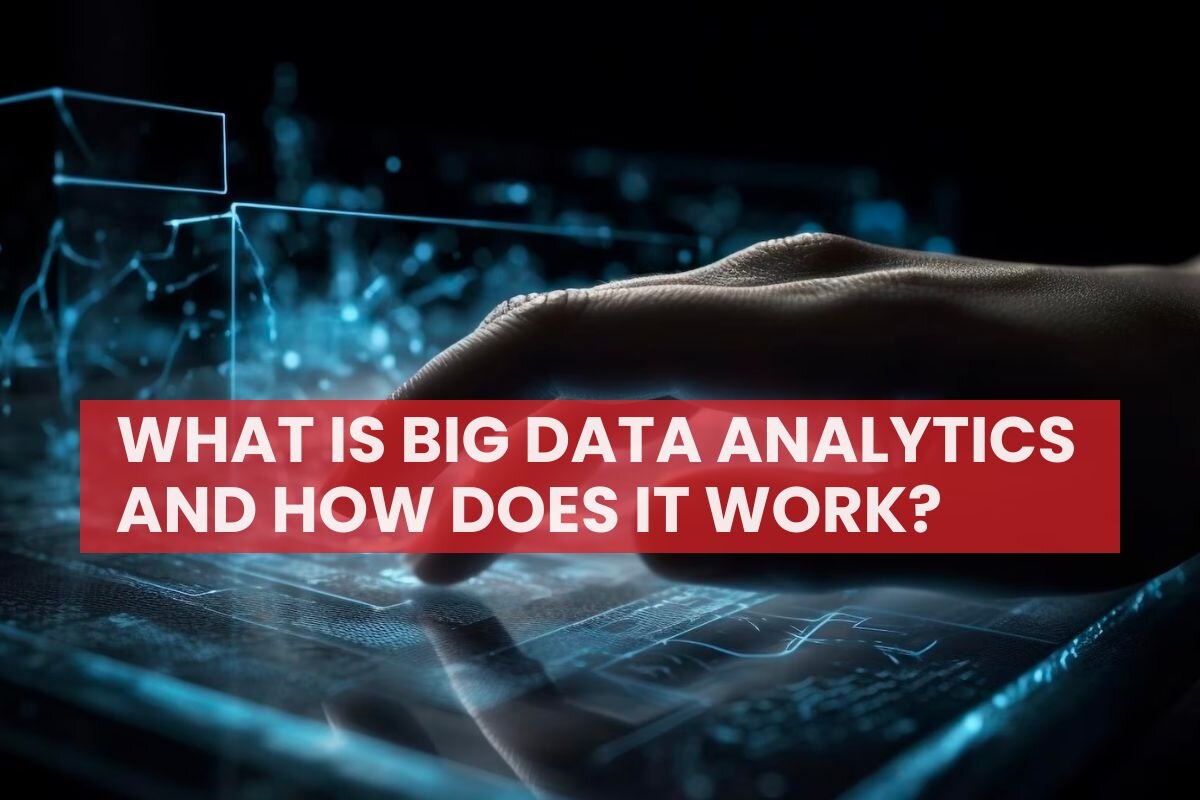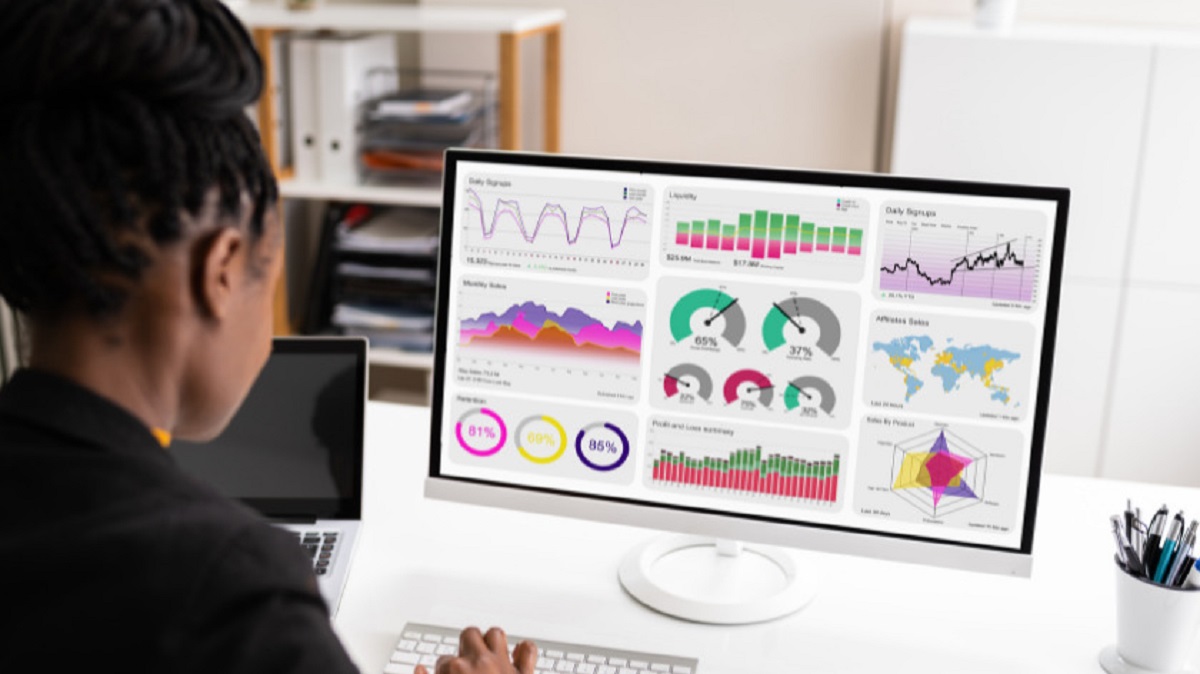Introduction
Welcome to the world of data-driven insights, where two terms often come into play: Big Data and Data Analytics. In today’s digital age, businesses and organizations are inundated with vast amounts of data. It has become crucial to effectively manage, analyze, and derive value from this data to stay competitive in the market.
Big Data and Data Analytics are two interrelated concepts that play a significant role in understanding and utilizing the potential of data. While they may seem similar, there are distinct differences between the two.
The term “Big Data” refers to the massive volume of structured and unstructured data that is generated from various sources such as social media, sensors, machines, and more. This data is characterized by its high velocity, variety, and complexity. Big Data provides valuable insights that can lead to better decision-making, customer understanding, and operational efficiency.
Data Analytics, on the other hand, focuses on extracting insights and meaningful patterns from the collected data. It involves the use of statistical analysis, machine learning, data mining, and visualization techniques to uncover trends, correlations, and relationships within the data. Data analysts use these techniques to make informed business decisions and drive strategic initiatives.
With an exponential growth in data, organizations need to leverage both Big Data and Data Analytics techniques to gain a competitive edge in the market. This combination allows businesses to identify patterns, predict future trends, optimize processes, and make data-driven decisions.
In this article, we will explore the key differences between Big Data and Data Analytics, understand their roles in the data ecosystem, examine their benefits, and discuss the challenges associated with their implementation. By gaining a comprehensive understanding of these concepts, businesses can harness the power of data and stay ahead in today’s data-driven world.
Definition of Big Data
Big Data refers to the enormous volume of both structured and unstructured data that is generated at a high velocity from various sources. This data is characterized by its velocity, volume, variety, and veracity.
The velocity of Big Data refers to the speed at which data is generated, collected, and processed. With advancements in technology and the proliferation of digital platforms, data is being generated at an unprecedented rate. This includes data from social media posts, online transactions, sensor readings, and more. This constant stream of data requires specialized tools and techniques to capture, store, and analyze it in real-time.
The volume of Big Data refers to the immense amount of data that is created and accumulated. Traditional databases and storage systems often struggle to handle such large volumes of data. To manage Big Data effectively, organizations employ distributed systems and technologies such as Hadoop and NoSQL databases. These technologies enable the storage and processing of massive amounts of data in a scalable and cost-effective manner.
The variety of Big Data encompasses the different types and formats of data that are generated. From structured data such as numbers, dates, and categories to unstructured data like text, images, audio, and video, Big Data encompasses a wide array of formats. This variety poses challenges for data analysis, as traditional methods may not be suitable for processing and extracting insights from all types of data.
The veracity of Big Data refers to the quality and accuracy of the data. With the vast amount of data being generated, ensuring its reliability can be a challenge. Data may be incomplete, inconsistent, or contain errors. Data quality management techniques are essential to identify and rectify any issues that may arise, ensuring that the data used for analysis is reliable and accurate.
Overall, Big Data represents the massive and complex universe of data that organizations must navigate. It offers a treasure trove of insights that, when properly harnessed, can fuel innovation, improve decision-making, and drive overall business success.
Definition of Data Analytics
Data Analytics is the process of examining, transforming, and modeling data to uncover meaningful patterns, correlations, and insights. It involves the use of various statistical techniques, algorithms, and visualization tools to extract valuable knowledge from data.
Data Analytics encompasses a range of methodologies, including descriptive analytics, diagnostic analytics, predictive analytics, and prescriptive analytics.
Descriptive analytics focuses on summarizing and describing historical data in a meaningful way. It helps answer questions like “What happened?” and provides a snapshot of past events and trends. Examples of descriptive analytics techniques include data aggregation, data visualization, and basic statistical analysis.
Diagnostic analytics aims to understand the reasons behind certain events or outcomes. It involves exploring the relationships between variables and identifying the factors that influenced a particular result. Diagnostic analytics techniques, such as regression analysis and root cause analysis, help uncover the underlying causes and provide insights into why certain events occurred.
Predictive analytics takes the analysis a step further by forecasting future outcomes based on historical data patterns. It uses statistical models and machine learning algorithms to make predictions and anticipate future trends or behaviors. Predictive analytics techniques enable organizations to make informed decisions and take proactive measures to seize opportunities or mitigate risks.
Prescriptive analytics goes beyond predicting future outcomes and offers actionable insights on how to optimize decision-making. It leverages advanced techniques such as optimization algorithms and simulation models to recommend the best course of action based on the desired outcomes and constraints. Prescriptive analytics empowers organizations to make data-driven decisions and achieve better operational efficiencies.
Data Analytics is not limited to traditional structured data. It also extends to unstructured data, such as text, images, and social media posts. Natural Language Processing (NLP) and sentiment analysis techniques enable the extraction of insights from unstructured data sources, providing valuable information for decision-making.
In summary, Data Analytics is a multifaceted process that involves extracting, analyzing, and interpreting data to unlock meaningful insights. By employing various techniques and tools, organizations can gain a deeper understanding of their data, uncover hidden trends, and make data-driven decisions to drive business growth and success.
Comparison of Big Data and Data Analytics
While Big Data and Data Analytics are intertwined in their role within the data ecosystem, there are several key differences that set them apart.
Big Data focuses on the storage, management, and processing of vast volumes of data. It deals with the three V’s: volume, velocity, and variety. Big Data technologies enable the handling of large datasets, both structured and unstructured, in real-time or near real-time. The goal is to capture and store data, ensuring it is accessible for analysis.
Data Analytics, on the other hand, is concerned with extracting insights and value from data. It involves using statistical techniques, machine learning algorithms, and visualization tools to analyze data and discover patterns, correlations, and trends. Data Analytics focuses on making sense of the data and turning it into actionable insights for decision-making.
Big Data is about the infrastructure and tools needed to manage and process large volumes of data, while Data Analytics is about the techniques and approaches to analyze and extract insights from that data.
Another difference lies in the skill sets required for each field. Working with Big Data typically requires expertise in data storage and processing technologies such as Hadoop, Spark, or NoSQL databases. Professionals working in Big Data need to have a strong understanding of distributed computing and database management.
Data Analytics, on the other hand, calls for skills in statistical analysis, data modeling, and machine learning. Data analysts need to be proficient in programming languages like Python or R and have knowledge of data visualization tools to effectively communicate their findings.
Furthermore, the focus of Big Data is more on the “how” – how to collect, store, and manage large volumes of data efficiently. In contrast, Data Analytics is more concerned with the “why” and “what” – why certain patterns or trends occur in the data and what insights can be derived from them.
While Big Data provides the foundation for data analysis, Data Analytics is the process of transforming raw data into meaningful information that can drive strategic decisions and actions.
In summary, Big Data and Data Analytics are distinct but interconnected fields. Big Data deals with the infrastructure and handling of large volumes of data, while Data Analytics focuses on extracting insights and value from that data. Both fields play essential roles in the data-driven decision-making process, enabling organizations to leverage the power of data for competitive advantage.
Key Differences Between Big Data and Data Analytics
While Big Data and Data Analytics are closely related, they have distinct differences in their focus, objectives, and methodologies. Understanding these differences is crucial for organizations looking to leverage the full potential of their data.
The primary difference lies in their scope and purpose. Big Data pertains to the storage, management, and processing of vast volumes of data, while Data Analytics focuses on extracting insights and value from that data. Big Data deals with the infrastructure and tools required to handle large datasets, whereas Data Analytics employs statistical techniques, machine learning algorithms, and visualization tools to analyze and interpret data.
Another key difference is their skill requirements. Working with Big Data necessitates expertise in distributed computing, database management, and technologies such as Hadoop, Spark, or NoSQL databases. Professionals in this field need to have a deep understanding of data storage and processing techniques. On the other hand, Data Analytics requires proficiency in statistical analysis, data modeling, machine learning, and programming languages such as Python or R. Data analysts focus on turning raw data into meaningful insights using various analytical techniques.
Furthermore, Big Data is concerned with the three V’s: volume, velocity, and variety. It revolves around managing and processing large volumes of data at high velocities while handling diverse data types and formats. In contrast, Data Analytics seeks to understand patterns, correlations, and trends within the data to derive actionable insights. It focuses on finding answers to the “why” and “what” questions rather than solely managing the data itself.
Big Data is foundational to Data Analytics as it provides the data infrastructure and storage capabilities necessary to support data analysis. Big Data technologies enable the capture, storage, and processing of large datasets, ensuring that the data is accessible for analysis. Data Analytics, on the other hand, utilizes the available data to uncover meaningful patterns and insights. It applies various techniques, such as regression analysis, clustering, and classification, to understand relationships and make predictions.
Overall, Big Data and Data Analytics serve complementary roles in the data ecosystem. Big Data sets the stage by providing the infrastructure and tools to handle large volumes of diverse data, while Data Analytics takes center stage in extracting insights for informed decision-making. Organizations should recognize the differences between these two fields and develop a holistic approach that incorporates both to harness the full potential of their data assets.
Role of Big Data in Data Analytics
Big Data plays a crucial role in enabling effective Data Analytics. It provides the foundation and resources necessary for extracting valuable insights from large and complex datasets. Without Big Data, the scale and depth of analysis achieved through Data Analytics would not be possible.
One of the primary roles of Big Data in Data Analytics is providing a vast amount of data that can be used for analysis. Traditional data sources often fall short in terms of volume and variety, limiting the scope of analysis. Big Data, on the other hand, encompasses structured and unstructured data from diverse sources such as social media, web logs, sensor data, and more. This extensive dataset enables more comprehensive analysis and allows for the identification of previously unseen patterns and relationships.
Big Data also plays a role in ensuring the accuracy and reliability of Data Analytics results. The sheer volume and variety of data make it possible to cross-verify and validate findings. By analyzing data from multiple sources and uncovering patterns consistent across different datasets, organizations can have greater confidence in the insights derived from Data Analytics. Big Data helps minimize bias and provides a more holistic understanding of the data landscape.
The velocity at which Big Data is generated is another critical factor in the role it plays in Data Analytics. Real-time and near real-time data analytics have become increasingly important in today’s fast-paced business environment. Big Data technologies, such as stream processing frameworks and distributed storage systems, enable organizations to capture, process, and analyze data on the fly. This real-time analysis allows for quick decision-making and helps organizations respond rapidly to changing market dynamics or customer demands.
Additionally, Big Data helps enhance the accuracy and effectiveness of predictive analytics in Data Analytics. By feeding large amounts of historical data into predictive models, organizations can make more accurate forecasts and predictions. The inclusion of Big Data in predictive analytics algorithms enhances the accuracy and reliability of predictions, enabling businesses to anticipate customer behavior, market trends, and potential opportunities or risks.
Moreover, Big Data supports advanced techniques such as machine learning in Data Analytics. Machine learning algorithms require vast amounts of data to train models and make accurate predictions. The availability of Big Data facilitates the training and optimization of machine learning algorithms, enabling organizations to develop more sophisticated and accurate predictive models.
In summary, Big Data plays a crucial role in the realm of Data Analytics. It provides the necessary volume, variety, and velocity of data to fuel comprehensive analysis and uncover valuable insights. Big Data enhances the accuracy, reliability, and real-time capabilities of Data Analytics, allowing organizations to make informed decisions, predict future trends, and gain a competitive advantage in today’s data-driven world.
Benefits of Big Data and Data Analytics
The combination of Big Data and Data Analytics offers a multitude of benefits for organizations across various industries. From improving decision-making to enhancing operational efficiency, leveraging Big Data and Data Analytics can lead to significant advantages.
One of the key benefits is the ability to gain actionable insights from large and complex datasets. Big Data provides a rich source of data that can be analyzed using sophisticated Data Analytics techniques. By uncovering patterns, correlations, and trends within the data, organizations can make data-driven decisions and identify opportunities for growth or optimization.
Another benefit is the ability to optimize business operations. By analyzing Big Data, organizations can identify inefficiencies, bottlenecks, or gaps in their processes. With the insights gained from Data Analytics, they can implement targeted improvements, streamline operations, and drive cost savings. For example, supply chain analytics can help optimize inventory management and reduce operational costs by predicting demand fluctuations and improving logistics.
Big Data and Data Analytics also enable organizations to enhance customer experiences. By analyzing customer behavior and preferences, organizations can gain a deeper understanding of their target audience and tailor products, services, and marketing efforts to meet their needs. This personalized approach leads to increased customer satisfaction, loyalty, and ultimately, higher revenue generation.
Furthermore, Big Data and Data Analytics play a crucial role in the realm of risk management. By analyzing vast amounts of historical data and external factors, organizations can identify potential risks and develop proactive strategies to mitigate them. Predictive analytics helps anticipate future risks and enables organizations to take preventive measures, reducing potential losses and ensuring business continuity.
The combination of Big Data and Data Analytics also facilitates innovation and new product development. By analyzing market trends, consumer patterns, and competitor insights, organizations can identify gaps in the market and develop innovative products or services to meet evolving customer demands. Data-driven decision-making through Data Analytics reduces the risk associated with introducing new products or entering new markets.
Moreover, the use of Big Data and Data Analytics allows for evidence-based policy-making in various sectors such as healthcare, public services, and urban planning. By analyzing large-scale datasets, decision-makers can gain insights into population health trends, resource allocation, and urban development. This leads to optimized resource utilization, improved public service delivery, and enhanced quality of life for citizens.
Lastly, Big Data and Data Analytics enable organizations to stay competitive in an increasingly data-driven digital landscape. By harnessing the power of data, organizations can gain a deeper understanding of their operations, customers, and market dynamics. This strategic advantage allows them to adapt quickly to changing trends and make proactive decisions based on data insights, positioning them ahead of their competitors.
In summary, the benefits of incorporating Big Data and Data Analytics into organizational strategies are significant. From actionable insights to enhanced operational efficiency, personalized customer experiences to risk mitigation, and innovation to evidence-based decision-making, leveraging Big Data and Data Analytics offers organizations a competitive edge and paves the way for sustainable growth and success.
Challenges of Big Data and Data Analytics
While Big Data and Data Analytics offer numerous benefits, organizations also face several challenges when dealing with these concepts. Understanding and addressing these challenges are crucial for successful implementation and utilization of Big Data and Data Analytics strategies.
One of the significant challenges is the sheer volume of data. Big Data encompasses massive datasets, which can pose difficulties in terms of storage, processing, and analysis. Traditional data management systems may struggle to handle the magnitude of data, requiring organizations to invest in specialized infrastructure and technologies such as distributed storage systems and data processing frameworks like Hadoop or Spark.
The variety of data is another challenge. Big Data encompasses structured, semi-structured, and unstructured data from various sources. Integrating and analyzing data from different formats and sources can be complex and time-consuming. Organizations need to invest in data integration and data cleansing techniques to ensure data accuracy and consistency across different datasets.
The velocity at which data is generated is a challenge for organizations. Real-time and near real-time analysis of streaming data require specialized tools and techniques to capture, process, and analyze data in real-time. Ensuring data integrity and accuracy while processing streaming data at high velocities can be demanding, requiring organizations to implement robust data governance and quality management strategies.
Data privacy and security are significant concerns in the realm of Big Data and Data Analytics. With large amounts of data being collected and analyzed, organizations must ensure the confidentiality and protection of sensitive information. Compliance with data protection regulations and implementing robust data security measures are essential to safeguard customer privacy and maintain trust.
Another challenge is the shortage of skilled professionals in the field of Big Data and Data Analytics. The successful implementation of these technologies requires individuals with expertise in statistics, machine learning, programming, and data visualization. Finding and retaining skilled data professionals can be difficult and costly for organizations, especially in highly competitive markets.
The complexity of analytical techniques and tools is also a challenge. Data Analytics requires a deep understanding of statistical modeling, machine learning algorithms, and data visualization techniques. Organizations need to invest in training and upskilling their workforce to effectively apply these techniques and interpret the results.
Moreover, the ethical use of Big Data and Data Analytics is an ongoing challenge. The responsible and ethical use of data requires organizations to ensure transparency, fairness, and accountability in their data practices. It involves being mindful of potential biases in data analysis and addressing any implications that may arise from the use of data.
In summary, while Big Data and Data Analytics offer immense potential, organizations must overcome challenges associated with data volume, variety, velocity, privacy, skills, complexity, and ethics. By recognizing and addressing these challenges, organizations can effectively harness the power of Big Data and Data Analytics to drive meaningful insights, informed decision-making, and sustainable business growth.
Conclusion
Big Data and Data Analytics have revolutionized the way organizations approach data-driven decision-making. The vast volumes of data generated at high velocities, coupled with the advanced analytical techniques, offer unprecedented opportunities for businesses to gain valuable insights and drive innovation.
Through this article, we have explored the definitions and differences between Big Data and Data Analytics. Big Data is concerned with the storage, management, and processing of large and diverse datasets, while Data Analytics focuses on extracting insights and value from that data through statistical analysis and machine learning algorithms.
We have seen how Big Data plays a crucial role in enabling effective Data Analytics. It provides the vast amounts of data needed to fuel comprehensive analysis, enhances the accuracy and reliability of predictions through machine learning, and facilitates real-time decision-making. Big Data forms the foundation for Data Analytics, providing the necessary infrastructure and resources for analyzing data and deriving actionable insights.
Moreover, we have highlighted the numerous benefits organizations can gain from leveraging Big Data and Data Analytics. From making data-driven decisions to enhancing operational efficiency, personalizing customer experiences to mitigating risks, and driving innovation to evidence-based policy-making, the combination of Big Data and Data Analytics offers significant advantages across various industries.
However, along with the benefits, we have discussed the challenges organizations face when dealing with Big Data and Data Analytics. These challenges include managing the volume and variety of data, processing data at high velocities, ensuring data privacy and security, acquiring and retaining skilled professionals, handling the complexity of analytical techniques, and maintaining ethical data practices.
To overcome these challenges, organizations need to invest in the right infrastructure, technologies, and talent. They must establish robust data governance and security measures, prioritize data quality and integrity, and cultivate a culture of data-driven decision-making. Continuous upskilling and training of employees is crucial to ensure proficiency in data analysis techniques and tools.
Ultimately, organizations that effectively leverage Big Data and Data Analytics will be able to gain a competitive edge, drive innovation, and make more informed and strategic decisions. By harnessing the power of data, organizations can unlock valuable insights, optimize operations, enhance customer experiences, and achieve long-term growth and success in today’s data-driven world.

























